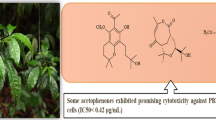Abstract
In an effort to increase of the antitumor activity of 2(S)-5,2′,5′-trihydroxy-7,8-dimethoxyflavanone isolated fromScutellaria indica, we synthesized its analogues,II, III, andIV. They showed potent cytotoxicityin vitro against cancer cell lines, L1210, K562 and A549. On the basis of ED50 values against the cancer cell lines,III exhibited about 2–7 times stronger activity thanI against various cell lines. We tested the antitumor activity of the analogues against Sarcoma 180 cellsin vivo and evaluated the structure-activity relationship. The antitumor activity appeared to be related to the hydrogen bond between carbonyl group at C-4 and hydroxyl group at C-5, in contrast to cytotoxic action.
Similar content being viewed by others
References Cited
Kingston, D. G., Samaranayake, G. and Ivey, C. A., The chemistry of taxol, a clinically useful anticancer agent.J. Nat. Prod., 53, 1–12 (1990).
Hamburger, M. and Hostettmann, K., Bioacvtivity in plants: the link between phytochemistry and medicine.Phytochemistry, 30, 3864–3874 (1991).
Bae, K. H., Min, B. S., Park, K. L. and Ahn, B. Z., Cytotoxic flavonoids fromScutellaria indica.Planta Medica, 60, 280–281 (1994).
Ryu, S. H., Ahn, B. Z. and Pack, M. Y., The cytotoxic principle of Scutellariae Radix against L1210 cell.Planta Medica, 51, 355 (1985).
Tanaka, T., Umimura, K., Iinuma, M. and Mizuno, M., Synthesis of flavonoids inScutellaria baicalensis Yakugaku Zasshi, 107, 315–317 (1987).
Fakas, L., Vermes, B. and Nogradi, M., The synthesis of wightin and echioidinin, two flavones fromAndrographis wightiana.Tetrahedron, 23, 741–744 (1967).
Miyaichi, Y., Imoto, Y., Tomimori, T. and Lin, C. C., Studies on the constituent ofScutellaria species (IX), On the flavonoid constituents of the Root ofScutellaria indica.Chem. Pharm. Bull., 35, 3720–3725 (1987).
Geran, R. I., Greenberg, N. H., McDonald, M. H., Schumacher, A. M. and Abbott, B. J.,Cancer Chemother. Rep. (part3) 3, 17 (1972).
Skehan, P., Storeng, R., Scudiero, D., Monks, A., McMahon, J., Vistica, D., Warren, J. T., Bokesch, H., Kenney, S. and Boyd, M. R., New colorimetric cytotoxicity for anticancer-drug screening.J. Natl. Cancer Inst., 82, 1107–1113 (1990).
Thayer, P. S., Himmelfarb, P. and Watts, G. L., Cytotoxicity assay with L1210 cellsin vitro. Comparsion with L1210 cellsin vitro and KB cellsin vitro.Cancer Chemother. Rep. (part 2) 2, 1 (1971).
Hellmann, K. and Carter, S. K.,Fundamentals of cancer chemotheraphy. McGraw-Hill Book Company, New York, 132–140 (1987).
Author information
Authors and Affiliations
Rights and permissions
About this article
Cite this article
Min, B.S., Chung, K.S. & Bae, K.H. Antitumor activity of 2(S)-5,2′,5′-trihydroxy-7,8-dimethoxyflavanone and its analogues. Arch. Pharm. Res. 20, 368–371 (1997). https://doi.org/10.1007/BF02976202
Received:
Issue Date:
DOI: https://doi.org/10.1007/BF02976202




